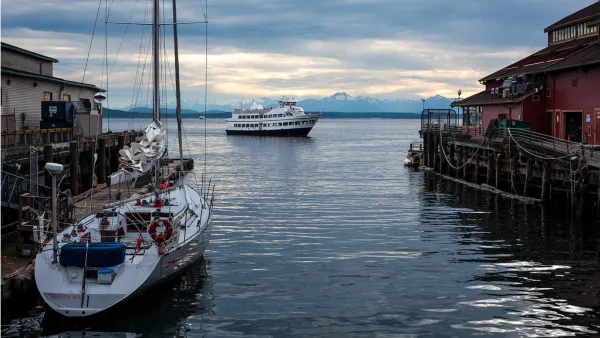The state's unique Clean Air Rule is called 'cap-and-reduce.' Businesses that fall under the cap are required to reduce emissions, just like California's cap-and-trade program. However, they can not be forced to purchase carbon credits.
"Under the new rule, businesses that are responsible for 100,000 metric tons of carbon pollution annually will be required to cap and then gradually reduce their emissions," according to the Department of Ecology, Washington's environmental protection agency.
If a business cannot limit its own emissions, it has other options. It could develop a project that reduces carbon pollution in Washington, such as an energy efficiency program. Businesses could also comply by buying carbon credits from others or from other approved carbon markets.
The plan relies on businesses to trade independently among themselves and with other markets. All emissions reductions, projects and trading would be validated by independent auditors with oversight from Ecology.
In California's cap-and-trade program [PDF], which held its first auction in November 2012, emitters are now required to purchase carbon allowances or offsets at quarterly auctions if necessary, unlike large emitters in Washington come Oct. 17, when the program starts. However, the future of the California program is very uncertain.
Initially the Clean Air Plan will "apply to 24 businesses that each produce at least 100,000 metric tons of carbon each year, including all five oil refineries in Washington, as well as power plants, fuel distributors and other industries," reports Samantha Larson, the science correspondent for Crosscut, the Pacific Northwest’s reader-supported, independent, non-profit electronic journal. "Collectively, they account for two-thirds of all the carbon pollution produced in the state."
A California-style cap-and-trade program as Gov. Jay Inslee's (D) original preference in 2014 with revenues used to fund a comprehensive statewide transportation program and schools. The carbon charge would have been 'the equivalent of the amount of revenue generated by a 12 cent gas tax increase, without the tax'," per Planetizen. As it turned out, Inslee got an 11.9-cent gas tax increase and a carbon cap.
“In short, the Clean Air Rule sets up a cap on carbon pollution in Washington and slowly reduces that cap over time,” Ecology Director Maia Bellon explained at a press conference held on the Seattle waterfront Thursday afternoon.
The measure, which operates under the state’s Clean Air Act, will require the targeted businesses to reduce their carbon emissions by an average of 1.7 percent each year.
After Inslee's initial attempt at carbon pricing failed, he directed Bellon to come up with a rule, which was launched in September 2015, reported John Stang for Crosscut.
There are "penalties for non-compliance," reports Bellamy Pailthorp environmental reporter for Seattle's KNKX Public Radio News.
Credits could also be earned through projects that reduce emissions, such as a digester at a dairy farm that converts methane from manure into energy instead of releasing it into the atmosphere.
A coalition of environmental groups issued a joint statement calling it an important first step and emphasizing the need for even more action to ensure that Washington meets its sustainability goals.
However, in July a small group of environmentalists engaged in a fast on the capitol steps as part of a protest against Gov. Jay Inslee's Clean Air Rule because they felt "the proposed rule doesn't go far enough," reported KNKX.
How the new rule, opposed by many Republican legislators and businesses, plays into the campaigns for and against the November revenue-neutral carbon tax measure, I-732, will be interesting to watch.
Also see:
- AP via The Seattle Times: State limits carbon pollution from large sources, Sept. 15
- Department of Ecology: Limiting carbon pollution through the Washington Clean Air Rule
From Planetizen:
- Gas Tax vs. Carbon Charge Debate Looms in Washington State, February 4, 2015
- Washington Governor Proposes Cap-and-Trade to Fund Highways, December 21, 2014
FULL STORY: State unveils new rules to combat climate change

National Parks Layoffs Will Cause Communities to Lose Billions
Thousands of essential park workers were laid off this week, just before the busy spring break season.

Retro-silient?: America’s First “Eco-burb,” The Woodlands Turns 50
A master-planned community north of Houston offers lessons on green infrastructure and resilient design, but falls short of its founder’s lofty affordability and walkability goals.

Delivering for America Plan Will Downgrade Mail Service in at Least 49.5 Percent of Zip Codes
Republican and Democrat lawmakers criticize the plan for its disproportionate negative impact on rural communities.

Test News Post 1
This is a summary

Test News Headline 46
Test for the image on the front page.

Balancing Bombs and Butterflies: How the National Guard Protects a Rare Species
The National Guard at Fort Indiantown Gap uses GIS technology and land management strategies to balance military training with conservation efforts, ensuring the survival of the rare eastern regal fritillary butterfly.
Urban Design for Planners 1: Software Tools
This six-course series explores essential urban design concepts using open source software and equips planners with the tools they need to participate fully in the urban design process.
Planning for Universal Design
Learn the tools for implementing Universal Design in planning regulations.
EMC Planning Group, Inc.
Planetizen
Planetizen
Mpact (formerly Rail~Volution)
Great Falls Development Authority, Inc.
HUDs Office of Policy Development and Research
NYU Wagner Graduate School of Public Service





























